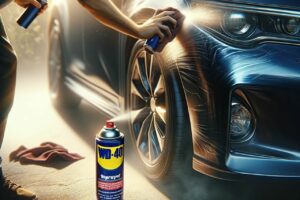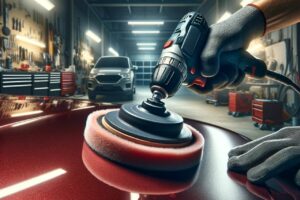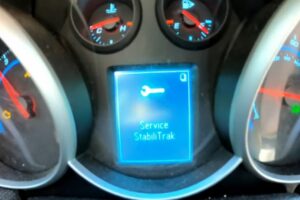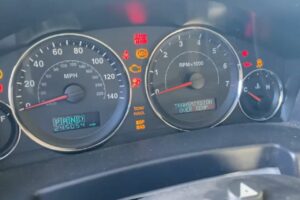If your car vibrates when it’s in drive but not in neutral, you’re probably wondering what could be causing this issue.
Well, fret not because we’ve got you covered! In this article, we’ll explore the various reasons why your car may vibrate in drive but not in neutral and provide some possible fixes for each one.
So, Why Car Vibrates In Drive But Not In Neutral?
One of the potential culprits behind this problem is bad motor or transmission mounts. Another possible cause could be a bad CV joint. This joint connects the driveshaft to the wheels and allows for smooth power transfer. Other factors that might contribute to this issue include a damaged drivetrain, uneven tire wear, low or bad transmission fluid levels, damaged wheel bearings, or a faulty tie rod.
Each of these components plays a crucial role in ensuring a smooth ride and any problems with them can result in vibrations while driving.
Table of contents
Car Vibrates In Drive But Not In Neutral: 7 Causes & Solutions:
| Cause | Symptoms | How to Fix |
|---|---|---|
| Loose or damaged engine mounts | The engine will shake or vibrate when the car is in gear, but not in neutral. | Tighten or replace the engine mounts. |
| Worn-out CV joints | The car will vibrate when turning or accelerating in gear. | Replace the CV joints. |
| Bad transmission mounts | The transmission will shake or vibrate when the car is in gear, but not in neutral. | Tighten or replace the transmission mounts. |
| Faulty wheel bearings | The car will vibrate when driving over bumps or uneven surfaces. | Replace the wheel bearings. |
| Uneven tire wear | The car will vibrate when driving at certain speeds. | Rotate the tires or replace the tires. |
| Misfire | The car will shake or vibrate when idling or accelerating. | Repair the misfire. |
| Fuel system problems | The car will shake or vibrate when idling or accelerating. | Repair the fuel system problems. |
1. Bad Motor or Transmission Mounts:

One of the possible causes for a car to vibrate in drive but not in neutral is bad motor or transmission mounts. The motor and transmission mounts are designed to support and stabilize the engine and transmission within the vehicle.
Here are some key points about bad motor or transmission mounts:
- What are motor and transmission mounts?
- Motor mounts: These are components that connect the engine to the vehicle’s frame, absorbing vibrations generated by the engine.
- Transmission mounts: Similar to motor mounts, these mountings secure the transmission system, minimizing vibrations caused by its operation.
- How do bad motor or transmission mounts cause vibration?
- Over time, these mounting components can wear out due to constant exposure to heat, pressure, and other factors.
- When they become worn or damaged, they may lose their ability to properly absorb vibrations from the engine or transmission.
- As a result, excess engine movement can occur during acceleration or deceleration phases in drive mode, leading to noticeable vibrations.

- Signs of bad motor or transmission mounts: Symptoms Description Excessive vibration Vibrations felt primarily when driving with load on engine Engine movement Abnormal movement observed during acceleration/deceleration Unusual noises Clunking sounds coming from underhood area
- Diagnosing and fixing bad motor/transmission mounts:
- Inspection: A visual inspection of mount conditions can help identify any signs of damage such as cracks, tears or sagging rubber.
- Replacement: If found faulty/damaged beyond repair capacity (e.g., torn rubber), replacing them with new ones is recommended.
- Professional assistance: Seeking help from a qualified mechanic ensures proper diagnosis and replacement procedures are carried out appropriately.
It is important to address bad motor or transmission mounts promptly, as neglecting the issue can lead to further damage and potentially affect other components in the vehicle’s drivetrain system.
By maintaining these mounts in good condition, drivers can enjoy a smoother ride with reduced vibrations.
2. Bad CV Joint:
A bad CV joint can be one of the causes why your car vibrates in drive but not in neutral.
The Constant Velocity (CV) joints are part of the drivetrain system and connect the transmission to the wheels, allowing power and torque to be transferred.
Here are some signs that you might have a bad CV joint:
If you suspect that your car’s vibrations are due to a bad CV joint, it is essential to address this issue promptly as driving with a faulty joint can lead to more severe problems such as complete failure and loss of control.
To fix a bad CV joint:
- Replace the entire axle assembly: In most cases, replacing just the individual boot or joint may not provide long-lasting results since other components within the axle assembly may also be compromised.
Preventive measures include maintaining proper lubrication by checking and replacing transmission fluid at recommended intervals and inspecting your vehicle regularly for any signs of damage.
If you experience vibrations specifically when driving but not in neutral, consider checking your car’s CV joints for potential issues like clicking noises, vibration during acceleration, grease leakage, torn boots which may require replacement of axle assembly ensuring overall safety on roads.
3. Damaged Drivetrain:
A damaged drivetrain can be one of the causes why a car vibrates in drive but not in neutral. The drivetrain is responsible for transferring power from the engine to the wheels, and any damage to its components can result in vibrations.
Here are some possible issues related to a damaged drivetrain:
It’s important to have a professional mechanic inspect your vehicle if you suspect that your car’s drivetrain is damaged as they will be able determine which component needs repair or replacement based on their expertise and diagnostic tools.
4. Uneven Tire Wear:
Uneven tire wear is one of the common causes of car vibrations in drive but not in neutral. When your tires are worn unevenly, it can lead to imbalances and disturbances in the smooth rotation of the wheels, resulting in vibrations while driving.
Here are a few reasons why you may experience uneven tire wear:
To prevent and address uneven tire wear issues:
- Regularly check and maintain proper air pressure according to manufacturer recommendations.
- Get wheel alignments done as recommended by professionals.
- Inspect suspension components for any signs of damage or malfunction.
- Rotate your tires regularly as per vehicle manufacturer guidelines.
- Replace worn-out tires promptly.
By addressing these causes and maintaining good tire care practices, you can minimize vibrations caused by uneven tire wear and ensure a smoother driving experience overall.
| Causes |
|---|
| Improper Wheel Alignment |
| Underinflated/Overinflated Tires |
| Suspension Issues |
5. Low or Bad Transmission Fluid:

If your car vibrates in drive but not in neutral, one possible cause could be low or bad transmission fluid. Here’s what you need to know about this issue:
- Symptoms of Low or Bad Transmission Fluid:
- Jerking or slipping when shifting gears.
- Delayed engagement when putting the car into gear.
- Overheating of the transmission.
- Burning smell coming from the engine.
- Causes of Low or Bad Transmission Fluid:
- Leakage due to damaged seals, gaskets, or transmission cooler lines.
- Insufficient fluid levels caused by neglecting regular maintenance and servicing.
- Effects on Your Car:
- Inadequate lubrication can lead to increased friction and heat within the transmission system.
- This can result in excessive wear and tear on various components, including clutch plates and bearings.
- How to Diagnose:
- Park your car on a level surface and engage the parking brake.
- Locate the transmission dipstick (refer to your owner’s manual if necessary).
- Remove the dipstick, wipe it clean with a cloth, reinsert it fully into its tube, then remove it again to check the fluid level.
- If the fluid is below “Full” or between “Add” and “Full,” you may have low transmission fluid levels.
- What to Do Next:
- If you notice low or bad transmission fluid:
- Check for any visible leaks under your vehicle – repair any damage found promptly by a professional mechanic
2.Change/Top up Transmission Fluid as per manufacturer’s instructions
3.Consider having a complete flush performed if recommended by your vehicle manufacturer
Prevention Tips:
- * Regularly check the transmission fluid level and condition.
- * Follow the manufacturer’s recommended maintenance schedule for fluid changes.
- * Inspect your vehicle for any signs of leaks or damage regularly.
Remember, low or bad transmission fluid can cause serious issues with your car’s performance. If you’re unsure about how to check or change the transmission fluid yourself, it’s always best to consult a qualified mechanic.
6. Damaged Wheel Bearings:
When your car vibrates in drive but not in neutral, one possible cause could be damaged wheel bearings.
Wheel bearings play a crucial role in the smooth operation of your vehicle’s wheels. They allow the wheels to rotate freely and help distribute the weight of the car evenly.
If you suspect that damaged wheel bearings are causing the vibration issue, here are some signs to look out for:
If any of these symptoms match what you’re experiencing, it’s essential to have your vehicle inspected by a qualified mechanic promptly. Ignoring damaged wheel bearings can lead to further damage and potentially dangerous situations on the road.
7. Bad Tie Rod:
A bad tie rod can also be a cause of car vibrations in drive but not in neutral. The tie rod is an essential component of the steering system, connecting the steering knuckle to the steering gear.
It helps control and maintain proper alignment of the front wheels.
Here are some reasons why a bad tie rod can lead to car vibrations:
- Misalignment: A worn-out or damaged tie rod can cause misalignment of the front wheels. When the wheels aren’t aligned correctly, it creates uneven tire wear and puts additional stress on other suspension components, resulting in vibrations while driving.
- Loose Connection: If the connection between the tie rod ends and other parts becomes loose due to wear or damage, it can affect steering responsiveness and stability. This looseness translates into vibration when there’s torque applied through acceleration or braking.
- Excessive Play: Over time, a bad tie rod may develop excessive play at its joints or bushings due to wear and tear. This excess movement causes instability in the front wheel assembly, leading to unwanted vibrations during driving.
To identify if a bad tie rod is causing your car’s vibrations, you may notice symptoms such as:
- Steering wheel shaking or vibrating.
- Uneven tire wear.
- Difficulty maintaining proper alignment.
- Clunking noises when turning.
Conclusion and final thoughts 💭
A car vibrating in drive but not in neutral can be attributed to several potential causes.
These include bad motor or transmission mounts, a bad CV joint, damaged drivetrain, uneven tire wear, low or bad transmission fluid, damaged wheel bearings, and a bad tie rod.
It is essential to identify and address the specific issue causing the vibrations in order to ensure optimal performance and safety on the road.
When experiencing vibrations while driving in gear but not when in neutral, it is crucial to have the vehicle inspected by a qualified mechanic.
They will be able to diagnose the exact cause of the problem through thorough examination and testing. Prompt action should be taken as neglecting these issues may lead to further damage and costly repairs down the line.
By addressing any of these potential causes promptly and effectively with professional assistance, you can restore smooth operation to your vehicle and enjoy a vibration-free driving experience once again.
Latest Posts:
- Can WD-40 Remove Scratches on Cars? (Hint: Yes, but…)
- Can You Use a Drill to Polish Your Car? (We Tried it Out!)
- Should You Cover Car Scratches With Stickers? (REVEALED!)
- Buick Service Stabilitrak: (Causes & 100% Guaranteed Fix!)
- Common Holden Trax Problems (Causes & 100% Proven Fixes!)
- Jeep Commander Transmission Over Temp: (Guaranteed Fix!)












Leave a Reply